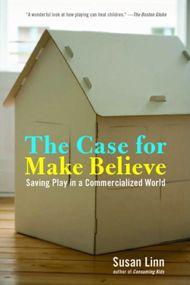
A book review, first published in the January 2001 issue of Welcome Home.
The Irreducible Needs of Children: What Every Child Must Have to Grow, Learn, and Flourish by T. Berry Brazelton, M.D. and Stanley I. Greenspan, M.D.
Nationally renowned for their clinical practices, their teaching, writing and researching, pediatrician T. Berry Brazelton and child psychiatrist Stanley I. Greenspan have joined forces to produce a groundbreaking book in which they aim “to challenge the status quo.” In the introduction, Dr. Brazelton and Dr. Greenspan explain:
"… caring for the families in our practices and engaging in studies of child development on a broader scale, we have become deeply concerned about the unmet needs of children…. Here, we have set out to identify the very most basic needs, the kinds of care without which children cannot grow, learn, and thrive. The ‘irreducible needs’ we will lay out are experiences and types of nurturing to which every child has a right. Yet by spelling out these needs, it becomes clear that at present our society is failing many of its families and small children. As physicians deeply committed to the well being of children, we can no longer stand by with the complacency that silence implies."
This book brings the doctors’ years of experience and sterling reputations to bear in answering the question asked a few years ago at a White House Conference on Infant and Child Development: What types of early experiences are vital for intellectual and emotional growth--and how much of each is necessary?
The irreducible needs are:
The need for…
- Ongoing Nurturing Relationships
- Physical Protection, Safety and Regulation
- Experiences Tailored to Individual Difference
- Developmentally Appropriate Experiences
- Limit Setting, Structure and Expectations
- Stable, Supportive Communities and Cultural Continuity
While all the ‘needs’ are important, the first is the cornerstone of this book. In the chapter titled “The Need for Ongoing Nurturing Relationships,” Dr. Greenspan discusses his fascinating observations about how emotional growth precedes and is critical for intellectual and moral growth.
"… we can't experience the consistency and intimacy of ongoing love unless we've had that experience with someone in our lives. For some it may be a grandmother or an aunt, or it may even be a neighbor, but it must be there. There are no shortcuts.
This basic feature of caring relationships between a baby and a caregiver who really knows her over the long haul is responsible for a surprisingly large number of vital mental capacities. The interactions that are necessary [to regulate behavior, moods, feelings, and intellectual development] can take place in full measure only with a loving caregiver who has lots of time to devote to a child. A busy day-care provider with four babies or six or eight toddlers usually won't have the time for these long sequences of interaction. Similarly, a depressed mom or dad or an overwhelmed caregiver with five children or parents too exhausted at the end of the day may not have the energy for these long patterns of interaction and negotiation."
In the section titled “A Child’s Day” Dr. Greenspan describes what kinds of interactions babies and children need, and places these interactions in broad categories so they can be used to set appropriate guidelines. They are: (1) being in the house but not in sight – he emphasizes that this is inappropriate for infants or toddlers who are awake; (2) presence, in sight and within hearing, but not involved in any interaction (each involved in his or her own activities); (3) intermittent availability, where the parent or caregiver is helping the baby explore a toy or helping a toddler explore his surroundings; and (4) direct involvement with the child (“the parent in essence, becomes the… object of interest.”) The last, “direct involvement” he refers to as “floor time.” It involves following the child’s lead and direct, continuous communication between the child and the parent or caregiver.
Dr. Greenspan acknowledges that in everyday life these different types of interactions merge into one another and often occur while the parent is going about daily tasks. Occasionally, he has found that parents or caregivers who ‘tend to get preoccupied and structured with their [own] tasks’ may need to set aside 20-minute periods during to day to focus on the last category, or ‘direct nurturing interactions.’ He also describes “relaxed availability” or “hanging out time” and its importance to children of all ages. In addition, he warns about the ‘easy baby’ who can get lost because he/she is content. “…simply because the child is not demanding involvement, interaction, and attention doesn’t mean the child wouldn’t benefit from them.”
At the end of this chapter, in the ‘recommendations’ section, Greenspan and Brazelton stake out a courageous and controversial position. First they acknowledge that non-parental care may be highly desirable or absolutely necessary in some circumstances. Still, they insist, “In the first three years, every child needs one or two primary caregivers who remain in a steady, intimate relationship with that child.” The doctors specify further that children under three spend at least two-thirds of their waking time involved in “two types of activities: [1] those in which the caregiver facilitates interactions with the environment and [2] direct interaction, such as cuddling, holding, shared pretend play, and funny face games.” For school-age children, “we recommend that of the available time two-thirds be spent with the caregiver being available for facilitating or directly interacting…. Parents should be available enough so they or the children don’t have to be measuring each moment of time and the guidelines outlined above can be taken for granted.”
On daycare the doctors say, “We do not recommend full-time day care, 30 or more hours of care [per week] by nonparents, for infants and toddlers if the parents are able to provide high-quality care themselves andif the parents have reasonable options.”
Brazelton and Greenspan make strong recommendations for drastically improving child care for those families who need it. The recommendations also tackle difficult situations including divorce and custody, with sample visitation guidelines, parenting plan and assessment guidelines provided. There is much to learn and to reflect on, with recommendations on a wide range of situations including a mother in jail, foster care, adoption regulations and TV (“In the first three years, no more than one half hour per day.”).
Several of us (from the FAHN organization) had the opportunity to hear Dr. Brazelton and Dr. Greenspan speak about their book in Washington D.C. last fall (1999). It’s heartwarming to see them describe the kind of emotional communication they value so highly. You can clearly see the love they have for babies and children in their eyes and gestures as they describe the developmental importance of a game of peek-a-boo or the negotiations with a toddler about cookies.
We certainly understand the doctors’ worry over the great numbers of children being cared for by persons other than their parents, and applaud their call for a rethinking of child care. “From the 1970s through the 1990s, there has been a transformation of the attitudes of families towards raising their own children. During this time, there has been a huge increase in the number of families giving up the care of babies, toddlers, and preschoolers to others for 35 or more hours a week.”
However, following this statement--or anywhere in the book--how we wish they had directly acknowledged the not insignificant number of families who have bucked the trend over the last thirty years and found ways to provide quality care for their own children. That information could have set a hopeful tone and provided direction toward support and information for those who are inspired by the doctors’ advice to seek ways to spend more time with their children.
Near the conclusion of their introduction, the doctors speculate on the reasons for the shift toward more impersonal care of children (and the elderly), and ask us to consider two sides of human evolution.
"We often associate human evolution with survival of the fittest, species competing with one another for survival. However, there is another trend, one that doesn’t often get associated with evolution per se, but may be a very important component of our development as complex human beings. This aspect of evolution has to do with the human being’s capacity to form families and cooperate in larger social organizations."
To have the skills to live in advanced societies, they say, children must be reared in nurturing, empathetic families. They note how we seem comfortable focusing on competitive survival but not on nurturance, which is associated with vulnerability and helplessness. They ask, “Could our need to deny vulnerability in ourselves mean that we have to deny seeing it in our children?” And they state “to have both parents take hold of the competitive mastery side and farm out the care of children to others… is an experiment that now must be reassessed in light of what we know that children require.”
The last chapter addresses global concerns. “Providing for the irreducible needs of infants and young children and their families is the first step in producing citizens of the world who can broaden their sense of humanity sufficiently to cope with the new interdependency of the world…. In order to protect the future for one child, we must protect it for all.”
Now, at last, we have unequivocal support from our nation’s leading doctors for what so many of us have known in our guts all along. The time we spend with our infants and children is crucial. Read this book. Get your friends to read it and discuss it together. Recommend it to newspaper columnists, talk show hosts, childbirth educators, prospective parents… anyone who can spread the word, personally put these recommendations into action for even one child, or help to support parents who are striving to meet these irreducible needs.
Reviewed by Cathy Myers, with Sharon Rutberg. Copyright 2001.
